Dr David Gruen and David Stephan1
The following speech was delivered by Dr David Gruen, Executive Director (Domestic), Macroeconomic Group, to the NSW Economic Society on 4 June 2010.
Introduction
Thank you for the opportunity to speak to you this afternoon.
My topic today is macroeconomic forecasts. I have a long-standing interest in this topic, having been involved in macroeconomic forecasting for quite some time. But the topic is of particular interest at the moment, because the global economy has been through such an extraordinary period, and it is worth reviewing how macroeconomic forecasts have fared over this time.
In my talk today, I will focus primarily on forecasts for real GDP growth. I will spend some time talking about the longer-term performance of Treasury’s forecasts. But I will spend most of my time looking at how both public and private sector forecasts evolved in the aftermath of the global financial crisis, and examining the performance of the forecasts presented in the 2009-10 Budget.
The year in review
But first, I think it’s worth considering where we have come from. As most of you will recall, last year’s Budget was prepared at a remarkable time.
The global financial system was gradually recovering from its cardiac arrest inSeptember 2008 but the degree of risk aversion nevertheless remained high.
The IMF had recently warned that the global economy was in the midst of ‘a severe recession inflicted by a massive financial crisis and acute loss of confidence’. It also cautioned that globally synchronised recessions, and those stemming from financial crises, tended to produce longer, deeper economic contractions, and slower recoveries, than usual business cycles.2
As well as the global outlook being decidedly grim, the uncertainty around the outlook was also greater than usual. The IMF estimated that the 90 per cent confidence interval around its April 2009 forecast for global growth in 2009 ranged from minus 3½ per cent to plus ½ per cent, with the risks weighted to the downside.
In Australia, substantial monetary and fiscal stimulus had been applied with unprecedented alacrity. Nevertheless, the relevant partial indicators for domestic output were extremely weak and had yet to show signs of improvement.
The available information was pointing to a significant economic contraction. The Budget forecast zero growth in 2008-09 and, in a first for a Budget, a contraction in GDP in the Budget year; that is a contraction of ½ a per cent in 2009-10. The forecast for 2010-11 was for moderate growth of 2¼ per cent.
These forecasts implied that output would remain well below its estimated potential level at the end of the forecast period. Because of this, the medium-term assumptions were revised to incorporate an extended period of above-trend growth (two years of 4½ per cent growth followed by four years of 4 per cent growth) to return output, gradually over time, to a level judged to be consistent with full employment.3
Upon release, there were, unsurprisingly, differing views about whether the economic growth forecasts in the Budget were about right or, alternatively, too optimistic or too pessimistic. For at least some commentators, however, the answer was clear.
The Rudd Government’s budget paints an unbelievable picture of a very mild recession (only a 0.5 per cent fall in GDP next year) followed by a recovery of 2.25 per cent in the election year (2010-11) and an above-trend rate of growth of 4.5 per cent in the following year.
Des Moore, On Line Opinion, 20 May 2009
If Prime Minister Kevin Rudd genuinely believes Treasury is conservative when it forecasts economic growth of 4 per cent within two years, then it would be interesting to know his definition of optimistic. Treasury officials are not used to being laughed at on budget night but, as soon as their growth forecasts were revealed, no other reaction was possible.
John Roskam, Australian Financial Review, 15 May 2009
As events have turned out, Australian economic outcomes have been significantly better than forecast in the 2009-10 Budget. The unemployment rate, forecast to peak at 8½ per cent in 2010-11, instead peaked at 5.8 per cent in July 2009, two months after the Budget was brought down, and now sits at 5.4 per cent (April 2010).
Chart 1: Real GDP — Budget forecasts and projections
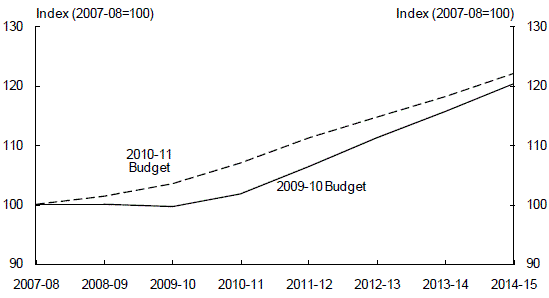
Source: ABS cat. no. 5206.0 and Treasury.
The more favourable outcomes and improved outlook for real GDP has led to a sizeable upgrade in the forecasts and projections for the level of real GDP in the 2010-11 Budget compared with the previous year’s (Chart 1).
The much milder downturn has also seen Treasury return to its standard medium-term projection methodology. That is, beyond the current forecast period (beyond 2011-12), the economy is assumed to grow at trend, with unemployment at its assumed full-employment rate of 5 per cent.
Of course, nothing is assured in the forecasting business, as the events in Europe over the past few weeks amply demonstrate.
Treasury’s forecasting performance
I now want to turn to Treasury’s longer-term performance when forecasting real GDP growth.
Chart 2: Evolution of Treasury forecasts for real GDP growth

Note: The Budgets for the years 1989-90 to 1993-94, as well as 1996-97, were released in August of those financial years.
Source: ABS cat. no. 5206.0 and Treasury.
Chart 2 shows the evolution of Treasury’s real GDP forecasts over the past two decades. The black dots show the Budget forecasts for real GDP growth for the Budget financial year. The thin black lines show how Treasury’s forecasts evolved in the lead up to, and following, the Budget. The horizontal thick black lines for each year reflect the first published outcomes (upon release of the June quarter National Accounts for the relevant financial year). The grey columns reflect the latest (March quarter 2010) official estimates of growth in the relevant years.
Table 1 presents summary measures of the performance of Budget forecasts for real GDP growth. The mean error is the average outcome minus the forecast. As shown, Budget forecasts have underestimated outcomes for real GDP growth by an average of less than 0.2 of a percentage point, implying minimal bias.
| Mean Error % points |
MAPE % points |
|
|---|---|---|
| Full Sample | 0.19 | 0.93 |
| 89-90 to 98-99 | 0.25 | 0.95 |
| 99-00 to 09-10 | 0.13 | 0.91 |
Note: Performance is measured against the most recent estimated outcome. Since the outcome for the
current year, 2009-10, is not yet known, we use the 2010-11 Budget forecast. For most financial years, Budget forecasts, which are released in May, relate to the subsequent financial year. The Budget forecasts
for the years 1989-90 to 1993-94, as well as 1996-97, were however released in August and relate to the financial year that had just begun.
The mean absolute percentage error (MAPE) is a metric with which t
o judge the accuracy of the Budget forecasts. Over the 21-year period 1989-90 to 2009-10, the MAPE is 0.93 percentage points, implying that, on average, Budget forecasts have been within ¾ to 1 percentage point of the outcome.
Splitting the sample (roughly) in half reveals that the MAPE is slightly smaller in the most recent 11 year period. However, economic growth has been less volatile in the past decade or so, with 2008-09 the only fiscal year in the 2000s in which growth was more than one standard deviation from trend. This has helped make recent forecast errors generally smaller (Table 1).
It is the nature of forecasting that errors will be larger around turning points in the economic cycle and smaller when the economy achieves stable, near-trend growth. Indeed, for most plausible stochastic processes driving GDP growth, optimal forecasts will exhibit the property that forecast errors are larger than average when growth outcomes turn out to be well above or well below trend.
In years where the economy grew well below trend (1990-91, 1991-92 and 2008-09) the Budget forecast errors are largest; with the MAPE around two thirds larger than the full-sample average.4
International context for the 2009-10 Budget forecasts
Let me now turn to the global economic outlook in the months leading up to the 2009-10 Budget.
As the global outlook deteriorated, the IMF downgraded its forecasts for 2009 global GDP growth by 4.3 percentage points between October 2008 and April 2009. Over the same period, it downgraded its forecasts for advanced economy growth also by 4.3 percentage points and for global trade volumes by over 15 percentage points (Chart 3).5
Chart 3: Evolution of IMF forecasts for GDP growth and trade volumes in 2009

Source: IMF World Economic Outlook Databases.
In line with these downgrades, Consensus forecasts for 2009 global GDP growth were cut by 3.7 percentage points (from 2.7 per cent to -1.0 per cent) between October 2008 and April 2009 (Chart 4).
Treasury’s 2009 global GDP growth forecasts were reduced by 4½ percentage points over a similar period (from 3 per cent in MYEFO 2008-09 to -1½ per cent in the 2009-10 Budget).6
For Australian goods and services export volumes, the IMF forecast a contraction of 7 per cent in 2009, while the OECD forecast contraction of 8 per cent. Treasury’s forecast was reduced, in several steps, from 6 per cent at MYEFO to -5¾ per cent at Budget.
The IMF and OECD inter-country trade models are probably the best available of their type. Treasury used them to gauge the impact of the contraction in global trade on Australian export volumes. Nevertheless, the somewhat stronger export volume forecast in the Budget, compared with the forecasts of the IMF and OECD, reflected Treasury’s judgment that Australia’s relatively lighter exposure to elaborately transformed manufactures (ETMs) would support a stronger result than in other advanced economies.
Chart 4: Evolution of Consensus and Treasury forecasts for world and G3 real
GDP growth in 2009

Note: G3 is the US, euro area and Japan, weighted by GDP at PPP.
Source: Consensus Economics, Treasury and calculations using IMF country weightings.
The outperformance of non-Japan Asia
How did global events turn out relative to the forecasts?
The contraction in global growth in 2009 occurred broadly as expected in April 2009. Importantly, however, this global outcome conceals different experiences across regions.
Chart 5 shows how Consensus forecasts evolved in two groups of countries chosen to illustrate the point — non-Japan Asia (which doesn’t include Australia), and the IMF advanced economies.
By April 2009, the Consensus forecast for 2009 growth in the advanced economies was remarkably close to the eventual outcome. By contrast, the forecast for non-Japan Asia turned out to be significantly too pessimistic.
Chart 5: Evolution of Consensus forecasts for real GDP growth in
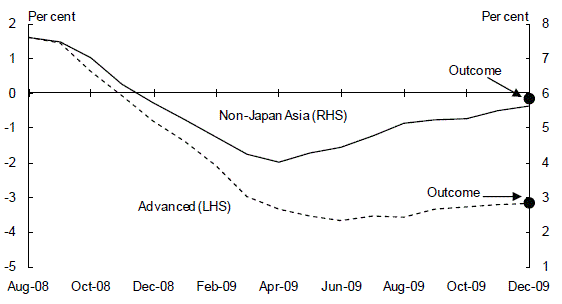
Source: Consensus Economics, IMF, Ecowin and Treasury calculations.
These countries had the significant advantage that their financial systems were not impaired. But an important contributing factor to their impressive performance was also the speed and size of the macroeconomic policy response, particularly in Korea and China.
Both countries eased monetary policy aggressively. Korea cut its base rate from 5¼ per cent to 2 per cent between October 2008 and February 2009. China implemented a series of measures, including relaxing credit restrictions and reserve requirements in late 2008 — and as a result credit growth in China accelerated extremely sharply in 2009.
Both countries also announced sizeable fiscal stimulus packages in late 2008, and implemented them quickly. As a result, the amount of discretionary fiscal stimulus applied by Korea and China in 2009, as a per cent of GDP, was among the largest in the world.
The domestic context for the 2009-10 Budget forecasts
Let me return now to the domestic economy in the lead up to the 2009-10 Budget. I want to begin by discussing the nature of the incoming evidence relevant to the domestic macroeconomic forecasts.
Along with the bleak outlook for the world economy, partial indicators for the domestic economy were also worrying.
The latest comprehensive reading on the economy, the December quarter 2008 National Accounts, released in early March 2009, showed a contraction of 0.5 per cent. At the time, this was the weakest quarter — indeed the first negative quarter — since the December quarter 2000. With subsequent revisions to the National Accounts, that quarter now stands as the weakest since March 1983.
The unemployment rate had risen quite quickly from 4.1 per cent in August 2008 to 5.7 per cent in March 2009.
Job advertisements presaged further weakness in the labour market. In March 2009, the ANZ total job advertisements series was around 45 per cent lower through the year, the sharpest annual fall in the 10-year history of the series.
Confidence, as measured in surveys, had also plummeted. Consumer sentiment was more than one standard deviation below its long-run average, while business investment intentions were more than 1½ standard deviations below their long-run average — a level not seen since the early 1990s recession (Chart 6).
Total bank lending to business, which had been growing strongly in 2007 and early 2008, slowed extremely sharply, and stopped growing towards the end of 2008 and into 2009.
Financial wealth had fallen by a third over 2008 and share markets by around half from their peaks in late 2007.
Chart 6: Consumer Sentiment and Business Investment Intentions in Australia
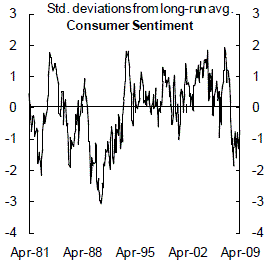
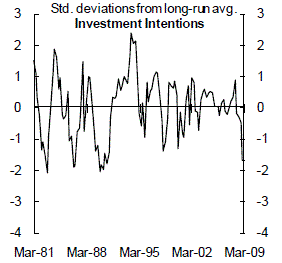
Source: Westpac-Melbourne Institute Survey of Consumer Sentiment and ACCI-Westpac Survey of
Industrial Trends.
The Budget forecasts were not alone in their pessimism. Consensus forecasts for Australian GDP growth in 2009 were downgraded at a fairly steady rate between September 2008 and May 2009. Treasury’s forecasts remained in step with the average private sector forecast at MYEFO and UEFO, but were slightly weaker than Consensus by the time of the 2009-10 Budget.7 Compared with both the IMF and OECD, Treasury remained somewhat more optimistic through the middle of 2009 (Chart 7).
Chart 7: Evolution of forecasts of Australian real GDP
growth in 2009
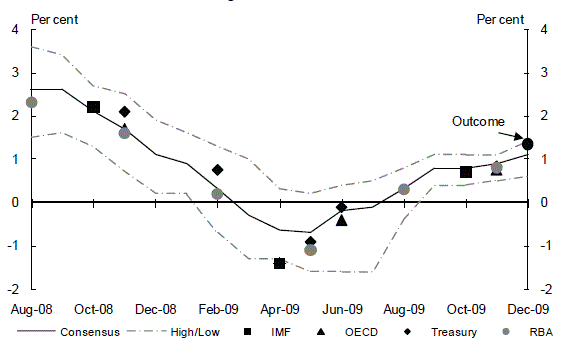
Source: ABS cat. no. 5206.0, Consensus Economics, IMF, OECD, RBA and Treasury.
By the time the Budget forecasts were finalised in April 2009, the average Consensus forecast was predicting 2009 Australian real GDP growth of around -0.6 per cent. The Budget forecast of -0.9 per cent was around the middle of the range of forecasts surveyed by Consensus in mid-April (Chart 8).8
Chart 8: Forecasts for Australian real GDP growth in 2009, as at April 2009
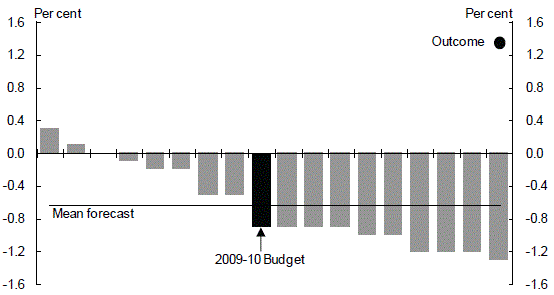
Source: Consensus Economics (survey date 14 April 2009) and Treasury (Budget, 11 May 2009).
As events turned out, of course, the economy performed significantly better than expected — although it did experience a significant slowdown. Annual growth in GDP, which had averaged 3.4 per cent over the period 2000-2007, slowed to 2.1 per cent in 2008 and 1.3 per cent in 2009.
More strikingly, the current dollar value of output was particularly weak. The fall in the terms of trade meant that nominal GDP growth through the year to September 2009 was the weakest it had been since the 1960s.
This renders the performance of the economy in real terms, together with the relative strength of the labour market, all the more remarkable.
Australian economic growth in 2009
Let me now discuss the outcome for Australian economic growth in 2009, as well as the factors responsible for the economy significantly outperforming the 2009-10 Budget forecasts.
Chart 9 shows contributions to real year-average GDP growth in 2009 by expenditure component. To aid understanding, imports — which of course do not contribute anything to GDP — have been netted off against each of the relevant expenditure components. The contribution from the change in inventories is also netted off.9
This treatment provides a clearer picture of the extent to which each of the components contributed to the GDP outcome.
Household consumption made by far the largest contribution (1.4 percentage points) to real GDP growth in 2009. Public final demand made the second largest contribution (0.9 percentage points). Next came business investment (0.4 percentage points) and exports (0.4 percentage points), while dwelling investment detracted 0.3 percentage points from GDP growth.10
Chart 9: Contributions to Australian real GDP
growth in 2009

Source: ABS cat. no. 5206.0 and Treasury. The contribution from ownership transfer costs to GDP(E) is not shown. Contributions are adjusted for imports and inventories (see footnote).
In preparing its forecasts, Treasury also primarily adopts an expenditure decomposition of GDP. Chart 10 details the contribution of each expenditure component to the real GDP growth forecast error in 2009 (that is, the outcome minus the 2009-10 Budget forecast), again after adjusting for the contributions of imports and inventories.
As Chart 10 reveals, business investment and exports contributed significantly to the forecast error. This is not, however, because either component made a particularly large contribution to the outcome for real GDP growth (see Chart 9). Instead, it is because the 2009-10 Budget forecasts for these two categories were particularly weak, and the outcomes turned out significantly better than forecast.
Chart 10: Contributions to 2009-10 Budget forecast error for real GDP growth in 2009
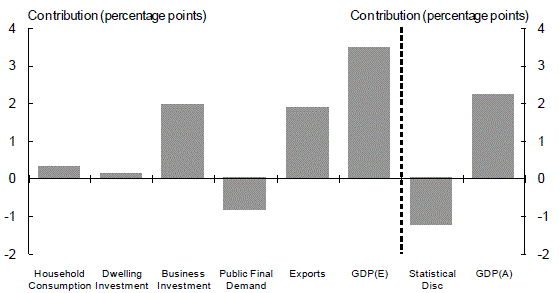
Source: ABS cat. no. 5206.0 and Treasury. The contribution from ownership transfer costs to GDP(E) is not shown. Contributions are adjusted for imports and inventories (see footnote).
Considerable downward judgment was applied to the Budget forecast for business investment. This judgement was applied partly on the basis of the very weak domestic indicators at hand. At the time, bank lending to businesses was slowing sharply, business surveys were uniformly pessimistic, and Treasury’s business liaison program indicated that businesses were planning to reduce capital expenditure significantly.11
The forecast for business investment was also influenced by the weak forecast for global growth at the time. The forecast weakness in exports and commodity prices was expected to act as a drag on business investment.
There are two main reasons why business investment contributed to 2009 real GDP growth, rather than detracting sharply from growth, as forecast in the 2009-10 Budget.
The first reason is the stronger-than-expected growth performance in non-Japan Asia, particularly China. And the second reason is the general strength of the domestic economy, where activity and confidence were supported by monetary and fiscal stimulus.
In particular, the Small Business and General Business Tax Break appears to have brought forward into 2009 significantly more business investment than was expected at Budget.
Turning to export volumes, we have seen earlier that both domestic and international forecasters were close to their most pessimistic around the time the Budget forecasts were being finalised. The forecasts for export volumes were significantly influenced by these global expectations and expert views on the scale of the downturn.
As events turned out, April 2009 forecasts of the scale of the contraction in the global economy and global trade were close to the mark. Australia did not experience such a significant fall in export volumes, however. Instead, Australian export volumes rose by 1.5 per cent in 2009.
Chart 11: Export volumes — Budget forecasts and outcomes for 2009
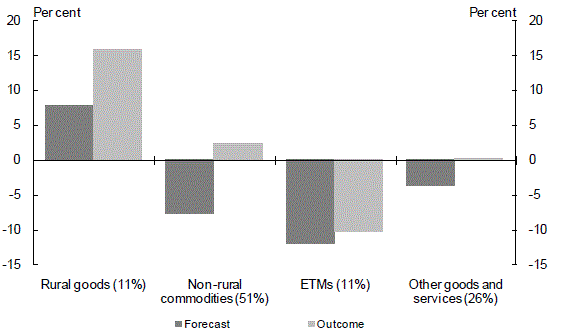
Note: Numbers in parentheses show each sector’s share of total goods and services export values. These detailed Treasury export volume forecasts for 2009 are previously unpublished.
Source: ABS cat. no. 5302.0 and Treasury.
Relative to the 2009-10 Budget forecasts, both non-rural and rural commodity exports performed significantly better than expected (Chart 11).
Non-rural commodity export volumes exceeded forecasts by a significant margin, although their growth of 2.2 per cent contributed only 0.2 of a percentage point to 2009 GDP growth.
This better-than-expected outcome largely reflected the strength of non-Japan Asia, particularly China. Chinese economic activity shifted into more commodity-intensive sectors, particularly infrastructure spending associated with th
e Chinese government’s stimulus packages. There was also substitution away from Chinese domestic production to imports as lower commodity prices resulted in the closure of some relatively high-cost Chinese production.
At the same time, better-than-expected rainfall led to a stronger recovery in rural commodity exports, which posted growth of over 15 per cent, and contributed 0.3 of a percentage point to 2009 GDP growth.12
On the other hand, the anticipated contraction in exports of ETMs was broadly realised. The volume of ETM exports fell by around 10 per cent, in line both with the fall in global trade volumes, and the Budget forecast.
The role of macroeconomic stimulus
One of the themes in the discussion thus far has been the role of macroeconomic stimulus in supporting economic growth in 2009. While the stimulus was explicitly factored into Treasury’s (and others’) forecasts, it is also a contributing factor to the Budget forecast errors.
Treasury estimates that domestic discretionary fiscal stimulus contributed about 2 percentage points to real GDP growth in 2009. This implies that real GDP would have contracted by about 0.7 per cent without fiscal stimulus.
These estimates include a significant contribution from public final demand (Chart 9). The contribution from public final demand is, however, smaller than was anticipated in the 2009-10 Budget (Chart 10), mainly due to some delays in spending. This has been offset by larger contributions from other elements of the stimulus packages. The cash payments between December 2008 and May 2009 — targeted to households more likely to spend them — appear to have provided a somewhat larger boost to household consumption spending than anticipated at Budget. And, as noted above, the business tax breaks appear to have brought forward into 2009 more business investment than was anticipated.
Treasury’s estimates of the contribution of fiscal stimulus to real GDP growth are derived using fiscal multipliers that we judge to be conservative (see Gruen, 2009, for more extensive discussion).
Given the substantial risk aversion, heightened uncertainty and low levels of confidence at the time, I think that adopting conservative assumptions for the fiscal multipliers was a reasonable thing to do.
As events have turned out, one reason the actual fiscal multipliers are probably larger than they were assumed to be is that they take insufficient account of the favourable feedback loop that expansionary macroeconomic policy — both monetary and fiscal — appears to have generated. Macroeconomic policy appears to have been large enough and quick enough to convince consumers and businesses that the domestic slowdown would be relatively mild. This, in turn, led consumers and businesses to continue to spend, and led businesses to cut workers’ hours rather than laying them off which, in turn, helped the economic slowdown to be relatively mild.
The rapid turnaround in sentiment that accompanied the growing realisation that the downturn would be mild is shown in Chart 12, which compares Australian sentiment indicators with those in the OECD.
Chart 12: Consumer sentiment and business confidence
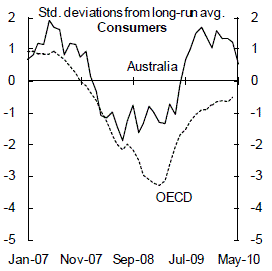
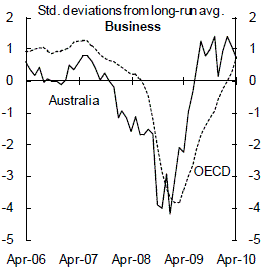
Note: For consumer confidence, the Australian series is the Westpac-Melbourne Institute Index of Consumer Sentiment and the OECD series is the OECD-total consumer confidence measure. For business confidence, the corresponding series are the NAB Monthly Business Survey and the OECD-total business (manufacturing) confidence measure.
To be most successful in limiting the severity of the downturn, the macroeconomic policy response had to be quick. For monetary policy, the official cash rate was cut with unprecedented speed — by 3¾ percentage points from early October 2008 to early February 2009.
For fiscal policy, a comparison with the US discretionary fiscal response in the aftermath of the collapse of Lehman Brothers in mid September 2008 provides a revealing demonstration of the timeliness of the Australian response.
In the United States, the 2008 Presidential election occurred at a critical time; a time when it would have been desirable to have been developing and implementing fiscal stimulus — as a comparison with the timing of the Australian fiscal packages makes clear.
The first Australian package (the $10.4 billion Economic Security Strategy) was announced in mid October 2008, a few weeks before the US Presidential election, with the first cash transfers to households distributed in early December.
The largest Australian package (the $42 billion Nation Building and Jobs Plan) was announced on February 3, 2009, two weeks after President Obama’s inauguration, and implemented rapidly thereafter.
By contrast, the post-Lehman US fiscal stimulus package, the US$787 billion American Recovery and Reinvestment Act was signed into law on February 17, 2009, and had minimal estimated impact on US economic growth until the June quarter, 2009 (Chart 13).
Chart 13: Estimated contribution of fiscal policy to GDP growth

Source: ABS cat. no.5206.0 and Treasury, Congressional Budget Office, 2010.
Conclusion
Making forecasts, particularly about the future, is a difficult task at the best of times. The task becomes all the more difficult when the global economy is in the midst of the largest synchronised downturn since the Second World War.
By April 2009, the global forecasting community had formed a pretty accurate assessment of the scale of the 2009 economic downturn in the advanced economies. Their assessment of economic prospects in non-Japan Asia, however, turned out to be overly pessimistic. Rapid and substantial easing of both monetary and fiscal policy, particularly in Korea and China, turned out to be more successful in stimulating growth, both in their own economies and in their close trading partners, than had earlier been expected.
In Australia, the 2009-10 Budget forecasts were put together at a time when both domestic and international forecasters were close to their most pessimistic — and thankfully economic outcomes have turned out significantly better than expected at that time.
Business investment and exports contributed significantly to the 2009-10 Budget forecast errors for 2009 real GDP growth. This was not, however, because either component made a particularly large contribution to the outcome for real GDP growth, but rather because the 2009-10 Budget forecasts for these two components were particularly weak.
Household consumption (adjusted for imports and inventories) made by far the largest contribution to real GDP growth in 2009, followed by public final demand, business investment and exports, while dwelling investment detracted slightly from growth.
From a broader perspective, the Australian economy benefited from the sound state of the financial system and from financial institutions’ continued capacity to borrow in international capital markets, supported by the Government guarantee. Australia also benefited directly from the commodity-intensive nature of the Chinese government’s stimulus packages, and from the rapid and substantial easing of domestic monetary and fiscal policy, without which Australia would have suffered a significant recession in 2009.
References
Congressional Budget Office
2010, Estimated Impact of the American Recovery and Reinvestment Act on Employment and Economic Output from January 2010 Through March 2010, Washington DC.
Council of Economic Advisers 2010, The Economic Impact of the American Recovery and Reinvestment Act of 2009, Third Quarterly Report, April, Washington DC.
Economic Roundup, Summer 2009.
Economic Roundup, Autumn 2005.
Gruen, David 2009, ‘The return of fiscal policy’, address to Australian Business Economists, 8 December.
http://www.treasury.gov.au/contentitem.asp?NavId=008&ContentID=1686
IMF 2008, World Economic Outlook Report, October, IMF, Washington DC.
IMF 2009a, ‘Group of Twenty’, paper prepared by the staff of the IMF for the G-20 Meeting of Deputies, 31 January-1 February, London.
IMF 2009b, World Economic Outlook Report, April, IMF, Washington DC. IMF 2009c, World Economic Outlook Report, October, IMF, Washington DC.
IMF 2009d, The State of Public Finances Cross-Country Fiscal Monitor: November 2009, November, IMF, Washington DC.
OECD 2008, Economic Outlook No 84, OECD, Paris. OECD 2009a, Economic Outlook No 85, OECD, Paris. OECD 2009b, Economic Outlook No 86, OECD, Paris.
OECD 2009c, Interim Economic Outlook, Chapter 3: The Effectiveness and Scope of Fiscal Stimulus, OECD, Paris.